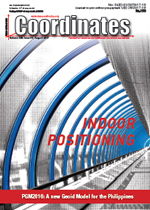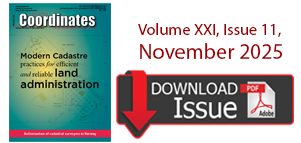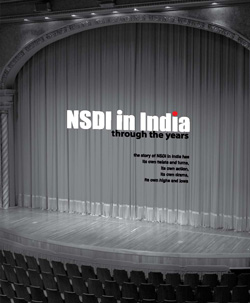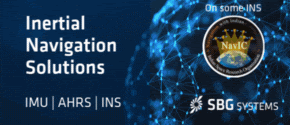Russia, China to set up pilot zone to test national navigation systems
Russia and China are set to establish a pilot zone to test the Russian GLONASS and Chinese BeiDou satellite navigation systems on passenger and freight transportation routes going through Kraskino – Hunchun and Poltavka – Dongning checkpoints on the border in Russia’s Primorsky …

Volume XIII, Issue 08, August 2017
Zip
Indoor Positioning Using Probabilistic Virtual Anchor Point Graphs
Eike Jens Hoffmann
Synchronet service demonstration results in DEMETRA H2020 Project
Enrico Varriale, Quirino Morante
GNSS data for ionosphere characterization
Josip Vukovic´ , Tomislav Kos
PGM2016: A new Geoid Model for the Philippines
R Gatchalian, R Forsberg, A Olesen
My Coordinates
EDITORIAL
Mark your calendar
SEPTEMBER 2017 TO …
September 2017
INSPIRE 2017
4 – 5 September, Kehl Germany 6 – 8 September, Strasbourg France
http://inspire.ec.europa.eu/events/inspire-conference-2017
Interdrone 2017
6 – 8 September Las Vegas, USA
www.interdrone.com
ESA-JRC Summer School on GNSS 2017
4 – 15 SeptemberSvalbard-Spitsbergen, Norway
www.esa-jrc-summerschool.org
56th Photogrammetric Week ‘17
11-15 September
Stuttgart, Germany
www.ifp.uni-stuttgart.de/phowo
ION GNSS+ 2017
25 – 29 September Portland, USA
www.ion.org
Intergeo 2017
26 – 28 September Berlin, Germany
www.intergeo.de
October 2017
GIS Congress-2017
2 – 3 October Vienna, Austria
https://www.bentley.com/en/yii/home
Year …

Artificial Wisdom
Elon Musk, the chief of Tesla and SpaceX
Has repeatedly been admonishing
On potentially apocalyptic future of Artificial Intelligence (AI)
and appealing for proactive regulations on AI.
However, MarK Zuckerberg, Facebook’s CEO
Has called Musk a ‘naysayer’
And termed his doomsday prophesy as result of unnecessarily negativity.
If the increasing obsession of mankind with …
China plans space-based, solarpowered telecom drones: Report
A research institute affiliated with China Aerospace Science and Industry Corp is developing the project “Feiyun,” which means “flying cloud,” the Global Times reported, citing another report in the Science and Technology Daily. The network will be based in “near space”, it said, adding the system will be …
Google’s Waze launches navigation app for car dashboards
Waze is bringing its navigation and traffic monitoring app to more than 100 models of car as it expands its satnav software beyond smartphones.
The app will be available in cars that use Android Auto, Google’s dashboard software, including models from BMW, Vauxhall, Renault, Ford and Volkswagen …














 (5.00 out of 5)
(5.00 out of 5)